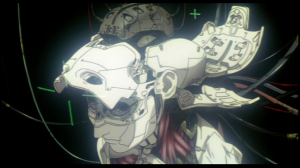
The integration of human and object, is what Bruce Sterling refers to the biot in his Shaping Things. He, as well as many depictions of the ‘cyborg’ usually create definition by examining the level of connectivity between the human and object whether it be some sort of external augmentation, embedded technologies, or intrinsically integrated beings. What this does not take into account is the mind/body duality described by DesCartes’ dictation of ‘I think therefore I am.” And to paraphrase the latter’s further description that the very fundamental conception of thinking means that I exist, but I can imagine myself elsewhere (in a dream, lucid thought, etc) and so although the mind is associated with one given body, the mind is separate and can be projected elsewhere. Our vast info-exchange networks can submerge our consciousness into experiential exchanges and very real subjectivities.
Embedded within this debate is the well-known metaphysical and philosophical dilemma known as the mind-body problem. Emergent from this dilemma are two bodies of thought; dualism (which can be further broken down into substance dualism and property dualism) and materialism/physicalism. Dualism describes the mind and body as two separate entities, substance dualism being the direct derivative of Descartes position.
Materialism holds that mind and body and both composed of matter or energy; that all things composed of material and all phenomena (including consciousness) are the result of material interactions. Matter is the only substance and reality is identical with the actually occurring states of energy and matter. I will assume that an individuals mind, consciousness, thoughts, are virtual by nature and thus run inconclusive to ideas of materialism, and that the body is a prosthesis or an extension of the mind. Clarifying this relationship will also be critical to the thesis.
The prosthesis allows us a phenomenological reach as well as a physical one. With the level of interconnectivity of today’s gizmos and objects, it is possible to project that prosthetics will be capable of similar or more advanced networking than are experienced by the smartphone and laptops of the day. As we create subjectivities or virtual realms around these devices, it is possible then to conceive of a networked or tethered subjective experience.
When looking to define subjectivity by creating a graphic to illustrate my intentions it is useful to examine Søren Kierkegaard’s idea of subjectivity; a closeness, believed and perhaps most importantly desired understanding of another’s presence or reality. In his particular definition of subjectivity he demonstrates his relationship with God, although the description not need be of a deity, but could certainly exist as some sort of élan vital or natural sentimentality. Kierkegaard’s visuals of external phenomena are more than simple illustrations of his ideas, they are clear and legible provocations of subjective qualities or methods of achieving inwardness that are manifest in the physical realm. He describes how strong one’s faith must be in order to establish a proper relationship to God, with passion so immense “so as to remain out upon the ocean’s deep, over seventy thousand fathoms of water, and still believe.” Particularly in this thought, Kierkegaard expresses the greatness and vastness of the ocean encompassing a finite and discrete singular individual. The dark of the ocean below, unsurrendering waves and an infinitely stretching ocean should do nothing to deter even the strongest believer (implying a desire to believe).
Without representational tools that illustrate externalized phenomena, Kierkegaard’s idea of infinite passion cannot be accurately represented. While it may be understood as lifelong dedication in totality to establishing a proper individual-God relationship through subjective understanding, it is not understood in a way that places a mentally palpable and expressible idea to the viewer. Without a real conception of the consequences of Kierkegaard’s passion, he cannot accurately express the magnitude of his infinite concern. The philosophical concept of the Sublime is a device Kierkegaard uses to visually demonstrate the importance of subjectivity by allowing individuals to construct a tectonic representation based on an a priori and knowable, physical reality.
What then, becomes the relationship of the individual and the subjective; one’s desires, beliefs, and perspectives? These projected realities that exist in our minds that we believe to be real or project into our physical domain, could be hacked, or altered by other individuals. Our desires could become parasites to others, confusing us about by blurring our true motivations or desires from those of others. Or perhaps in a the relationship becomes like that of a hive; and all knowing and all believing or all desiring human exocortex of a reservoir of potentials and projections.